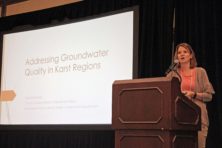Brown Water
- Share
- Tweet
- Pin
- Share
On Sept. 23, the Kewaunee County Board will consider a groundwater ordinance that will ban the spreading of liquid manure on thin topsoil land (20 feet or less) from Jan. 1 to April 15. The following tells the story of one family’s exodus from Kewaunee County due to the proliferation of concentrated animal feeding operations (CAFOs).
Thanks to brown, smelly water coming out of her tap in 2004, Judy Treml went from not having a clue about groundwater to being an advocate for others whose wells have been polluted by foolish farm practices.
It all began for the Treml family in February 2004. Six-month-old daughter Samantha was exclusively breast fed, and now her pediatrician wanted her to have a bottle of water daily for the fluoride content, but first he asked the family to test their well water for fluoride.
“On Feb. 4 we had our well tested,” Judy said. “Tests showed minimal amounts of fluoride, no coliform bacteria and nitrate levels were under the cutoff.”
Samantha’s doctor prescribed a fluoride supplement for her.
About 2 1/2 weeks later, a CAFO operator began spreading 80,000 gallons of liquid manure on a 40-acre field across the road from the Tremls, with the permission of the Department of Natural Resources. The farmer’s manure pit was at capacity, so he was told to spread the excess manure. The field was covered by 18 inches of snow that was in active melt at the time he decided to do the spreading.
“It was 40 degrees outside,” Judy said.
Worse yet, the field had fractured outcroppings of bedrock.
“He should never have spread there, not even on a summer day, because the fractured bedrock was so close to the surface,” Treml said.
When her husband, Scott, came home from work, he saw the manure running off the field and across the front yard of a neighbor across the street.
“So he went out there and stopped the farmer in the tractor and told him to stop spreading because it’s running off the field. The farmer said he was going to continue because he was in compliance with the DNR,” Judy said.
Scott contacted the DNR enforcement person for Northeast Wisconsin at that time, who said he would check it out. They never heard from him, so Scott started videotaping the flow of liquid manure from the field, into a ditch, across the neighbor’s property and into Rio Creek, which ran through the back of the Treml’s 80-acre property.
Three days later the Tremls neighbor from across the street brought them a mason jar of black water that came from her tap.
“I felt bad about her water, but I thought, better her than us,” Judy said. “I had no idea that manure can seep through the soil into our well. Our well was a great distance from where he was spreading. I had given Samantha a bath on Sunday, not even thinking about it. Our water had just tested clean a few weeks before. I thought, ‘We’re good.’”
Scott offered to bring the jar of tainted water to work with him in Green Bay on Monday and show it to DNR officials. He first called the DNR office and was told by the person in charge of water quality that he was a busy man and didn’t have time to talk about a jar of black well water.
When Scott got home from work, he was telling Judy about his encounter with the DNR official while she was doing something in the kitchen. She turned on the tap and the water ran brown.
“It smelled like cow manure, like I was standing in the middle of a barn. I turned it off and turned it on, and it was getting browner. The more I ran it, the browner it got,” she said. “I turned around and said to Scott, ‘You need to contact the DNR and get them out here.’ He said, ‘Judy, you don’t understand. They don’t care. They told me to call someone else.’”
So Judy did call someone else – every news organization she could think of.
“I was furious,” she said. “I told them what was going on and that the DNR wasn’t helping. Every one of them said the same thing, their first question was, if we come out to your house, will we see manure coming out of your tap? The next day, every news station in Green Bay turned up. In spite of that, the DNR never contacted us.”
The same day the TV cameras came to the Treml property, the Kewaunee County Land and Water Committee was meeting, so Judy bundled up her kids and brought a jar of her water and another of her neighbor’s water. The DNR was also there, and when they were invited to respond to what was going on, they said the farmer had done nothing wrong.
“Even though they knew manure was running everywhere,” Judy said.
As she and her kids were leaving the meeting, a man she never met said, “The DNR won’t help you.”
“He handed me the card of Andrew Hanson of the Midwest Environmental Advocates (MEA),” Judy said.
“I was not a litigious person. I didn’t believe in that,” Judy said, “but we didn’t know what to do. We didn’t know if the kids were going to get sick.”
The next day, a DNR representative arrived at the Treml residence to take a water sample.
“Two days later I got a call from the Public Health Department, telling me to shut my water off and remove the kids from the house. The e-coli count was 10,000 parts per milliliter. The coliform counts were 100,000 parts per milliliter. It only takes 1,000 parts per milliliter of e-coli to close the Algoma beach. I didn’t know where to go with three kids.”
The Tremls learned the DNR had no interest in pursuing the case.
“That forced our hand,” Judy said. “So we called MEA and met with Andrew Hanson. We gave him our information and the evidence we had. He said, ‘I think you have a good case.’ So we hired them. Because we had video evidence of manure running into Rio Creek, that was a violation of the (federal) Clean Water Act. That’s how we started litigation, in federal court, not state court.”
The day after the Tremls went public with their notice of intent to sue, the DNR issued a notice of violation to the farmer.
“What that did to our clean water case in federal court, their case trumped our case. Instead of being pulled out of federal court, the judge let us petition to become interveners,” Judy said.
The Tremls eventually won a damage award, and the CAFO operator was issued a fine, but in the process, the Tremls learned more about the shoddy CAFO implementation procedures.
“The DNR gave the CAFO operator a permit on July 18, the year before our well was polluted, and at that time he didn’t have adequate manure storage. They gave him a permit to expand his herd, knowing he did not have adequate manure storage and not writing anything in his permit that he had to improve his storage,” Judy said. “That’s how we ended up with the predicament he found himself in February. He was able to add to his herd without adding to his storage. Over the years, that has been a bone of contention. CAFOs are required to have six months worth of storage. The ordinance (coming before the Kewaunee County Board on Sept. 23) is asking them to stop spreading from January to April. If they are required to have six months of storage, this should be a non-issue.”
Because of all the publicity the Tremls received during the court battle, Judy started getting phone calls from other distressed families in the same circumstances.
“In 2005 the Town of Morrison had more than 100 wells go bad,” she said. “The Town of Morrison called the DNR and the DNR was not responsive to their calls. So who did they call? I was getting calls from the Town of Morrison about what they should do. That’s how I started working with communities. After Morrison, it was the Town of Cooperstown in southern Brown County. I had a family from Beaver Dam call me, with a situation identical to mine, a husband, wife and three daughters. They had brown, smelly water coming out of their tap after a CAFO spread manure on frozen ground. The DNR did respond to that case.”
In 2010, the family made the bittersweet decision to move from their rural Luxemburg home to Green Bay.
“That was a family farm. It was my husband’s great-grandfather’s homestead. We remodeled it and lived in it. It was something my husband always wanted to do. It was a three-story brick foursquare house. We had no plans on moving but we needed our kids to be safe,” Judy said. “When we bought our house, there was one CAFO within a two-mile radius of our home. In 2010 when we decided to sell, we were going on our sixth CAFO in a two-mile radius. My husband runs a successful business in Green Bay. He saw the writing on the wall. He said if we don’t get out now, our land is going to be worthless. We didn’t want to leave. I would call it more of a business decision. That land was our equity. It was going to be part of our retirement. That was our asset, if you will. But having that many CAFOs in that concentrated of an area, that house was not going to be worth anything. Yes, we did move because of that, the changing landscape of that area. It had just become overwhelming.”
Like others who testified at a Sept. 9 public hearing on Kewaunee County’s proposed groundwater ordinance, Judy said if it passes, it is just a very small step in the needed direction.
“This ordinance is just a tiny little part of Wisconsin that will be impacted. We need this statewide,” she said. “Kewaunee County needs it right now, but we need to close this gap in the state. Right now, nobody in the state is responsible. They have no way to regulate animal waste.”


